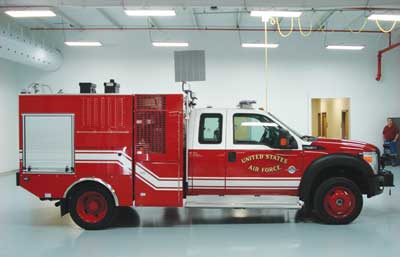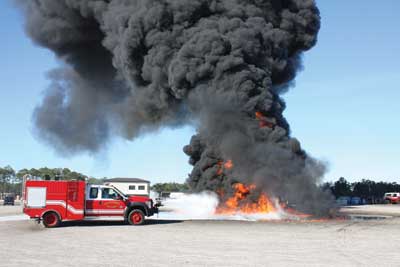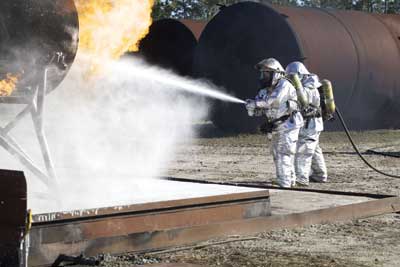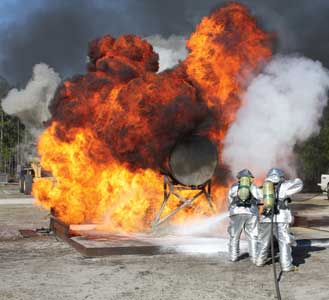By GREGORY G. NOLL
The United States Air Force (USAF) is imple-menting a new tool in its fire protection toolbox for aircraft rescue firefighting (ARFF) applications. Over the past decade, the USAF has conducted extensive testing on the application and use of ultra high pressure (UHP) firefighting technology for ARFF operations. This testing has resulted in the delivery of a new ARFF vehicle in the USAF’s fire protection community, an operational capability that will likely influence ARFF fire protection in both the military and civilian communities over the next decade.
This article provides an overview of the USAF UHP program, the new USAF P-34 rapid intervention vehicle (RIV) (photo 1) that deploys the UHP capability, and the USAF’s application and use of UHP for ARFF purposes.
 |
| (1) Photos courtesy of U.S. Air Force/Eddie Green. |
WHAT IS UHP?
The use of UHP for ARFF applications has been researched and tested by the Air Force Research Laboratory (AFRL) at Tyndall Air Force Base (AFB) in Florida over the past decade. Although the basic concepts of applying high-pressure water streams remain the same, there are significant differences in the operational capability of UHP and the high-pressure units previously used by the fire service today. Both AFRL and industry researchers have found that by increasing the pressure and flow rates, dramatic increases in fire protection performance for Class B fires can result.
Military aviation assets are deployed in locations throughout the world; fire protection is one of the initial operational requirements in establishing an airfield. With this in mind, the goal of the USAF research project was to develop an ARFF firefighting system that exceeded the effectiveness of current technology while reducing the amount of agent needed to extinguish a burning aircraft. Ultimately, the AFRL UHP project demonstrated that through the careful scaling of the UHP technology, a 300-percent improvement in firefighting efficiency could be obtained.
How is this performance improvement accomplished? UHP expels smaller water droplets than a low-pressure system, thereby increasing the total surface area up to four times and producing more surface area contact with less water usage. When combined with Class B firefighting foams, this technology allows a vehicle equipped with UHP technology to perform three to 3½ times more effectively than a conventional ARFF vehicle equipped with a low-pressure foam application system.
THE USAF UHP DELIVERY SYSTEM
The P-34 RIV is the newest addition to the USAF crash response fleet and is the first vehicle to employ the UHP technology in the military field. Leveraging the capabilities of the UHP system, the P-34 was developed as a faster, more efficient tool for replacing the aging P-19 ARFF vehicles that have been in use since the mid-1980s. The P-34 RIV is a standard Ford F-550 chassis with a 19,500-pound gross vehicle weight (GVW) combined with the UHP firefighting system. Staffed by up to three firefighters, the RIV has a pump-and-roll capability especially suited for ARFF operations both on and off the airfield.
Components of the P-34’s UHP firefighting system include the following:
- Water pump—four-stage, high-pressure centrifugal water pump powered by a Deutz six-cylinder, 174-horsepower (hp) diesel-powered, air-cooled engine.
- Water tank—400-gallon capacity.
- Foam proportioning system—electronic foam proportioning system with concentrations ranging from zero to seven percent.
- Foam tank—56-gallon capacity with a 7.5 gallon-per-minute (gpm) tank fill capability.
- Bumper-mounted turret nozzle (photo 2)—operated by a joy stick in the cab, it flows 60 gpm @ 1,350 pounds per square inch (psi).

(2) - Handlines—two one-inch, 200-foot hose reel handlines flowing 15 gpm @ 1,100 to 1,500 psi.
UHP TACTICAL RESPONSE CONSIDERATIONS
As a RIV, the P-34 can easily and efficiently maneuver in and around a flight-line environment as well as have the capability to operate in airfield perimeter areas. It is not designed to replace the high fire flows that can be achieved by the larger ARFF units such as the P-23 and so on. However, it does provide the USAF with another tool in its fire protection toolbox to ensure that airfield fire protection can be provided at a wide range of worldwide locations.
Depending on the response scenario, Class A or Class B firefighting foams can be used on the P-34 as follows:
- Foam concentrate can be employed through the vehicle’s “fixed proportioning system” or through the use of a portable in-line foam proportioner.
- Class A foams can be applied at a one-percent concentration for wildland fire scenarios.
- The USAF uses “regular” aqueous film-forming foams (AFFF) for aircraft crash and rescue operations. The P-34 is equipped with 56 gallons of three-percent AFFF. AFFF for ARFF applications is normally applied at three-percent concentrations when using low-pressure systems. However, USAF and AFRL field tests show that AFFF proportioned at a six-percent concentration produces a more fluid and stable foam blanket.
As a result of AFRL’s extensive testing process, the P-34 and its UHP system have demonstrated an effective operational capability for a number of ARFF response scenarios, including the following:
-
Support initial aircraft fire and rescue operations. The P-34 has demonstrated the ability to control and extinguish moderate-size spill scenarios common to aircraft accidents. AFRL coordinated more than 125 test fires on fire training pits ranging from 65 feet (3,318 feet2) to 100 feet in diameter (7,854 ft2), which included both fighter and large frame aircraft props. Test fire findings included the following:
- —The UHP turret and handline systems provided good expansion ratio and drain times, indicating a good quality foam.
- —The UHP turret and handline systems showed excellent throw distances. The UHP turret provided a 50-percent improvement in throw distance compared to the National Fire Protection Association (NFPA) minimum requirements for bumper turret systems.
- —AFRL testing of the UHP turret at four-, five-, and six-percent foam concentrations showed that the amount of three-percent foam concentrate could be increased to four percent without affecting firefighting performance or burnback protection.
- —Applying firefighting foam at the base of the fire is a more effective application technique and results in faster extinguishment than the traditional “raindrop” technique that has been used with AFFF from low-pressure application devices.
- —Fire operations must be conducted from an upwind position.
-
Engine and three-dimensional running fuel fires. The application of UHP foam and water streams on engine fires results in less damage to both jet and turbine engine systems than the use of Class B foam and dry chemical extinguishing agents. In addition, UHP handlines consistently extinguished running and compartment fuel fires (photos 3, 4). UHP foam and water used approximately 50 percent less agent by weight compared to Halon 1211. UHP foam and water is an acceptable agent for three-dimensional and hidden fuel fires such as those in engine nacelles.

(3) 
(4) - Penetrates hidden fires within the aircraft structure. This is true especially on aircraft constructed of composite fibers (e.g., B-2, Boeing 787, and so on).
UHP has also been an effective tool for several other fire protection risks. Although developed specifically for ARFF applications, the P-34 will also be effective in supporting wildland firefighting operations at USAF installations. The USAF fire protection community is in the process of acquiring 238 P-34s, with the initial round of deliveries already underway. Each USAF installation (i.e., active duty, Air Force Reserve, Air National Guard) will receive at least one RIV; larger bases will receive two.
THE FUTURE OF UHP
This project marks the beginning of UHP for ARFF applications. The USAF has also conducted testing with the UHP technology applied to the current P-19 ARFF vehicle, thereby serving as the test bed for the next generation of deployable ARFF vehicles. As the P-34 is the first ARFF unit based on the UHP technology, the USAF expects to eventually see its usage reflected in Federal Aviation Administration and NFPA standards and requirements.
In 2010, AFRL published the results of field tests pertaining to the installation of UHP prototype systems on the P-19 ARFF vehicle. The field test process included research conducted at AFRL at Tyndall AFB as well as the deployment of UHP-configured P-19s to five USAF contiguous United States fire departments that have never employed UHP technology. These test sites provided variation in local weather and environmental conditions, especially with winds and ambient temperatures.
Among the conclusions of the 2010 AFRL report were the following:
- UHP foam and water should be considered a suitable replacement for dry chemical and gaseous agents used for hidden compartment and running fuel fires.
- UHP turret foam and water should be considered a suitable replacement for low-pressure, high-flow roof turrets.
- UHP handline foam and water should be considered a suitable replacement for low-pressure, high-flow handline nozzles.
- Continue to meter the three-percent AFFF concentrate at three percent for CAF, four percent for UHP turret, and six percent for UHP handline operations.
- Use an electronic foam proportioning system to more accurately meter the foam, especially if using the UHP and CAF turret and handline systems, which require three different proportioning rates.
The ARFF community has witnessed numerous innovations and changes since its growth and maturity in the post-World War II era. They have impacted the design and construction of apparatus, the selection of extinguishing agents (e.g., movement from protein foam to AFFF), and the corresponding strategies and tactics. The development of the P-34 and the use of UHP extinguishing systems are steps in that continuing journey. It is not the “silver bullet” of ARFF fire protection but another tool in the ARFF community toolbox of available tools and resources as we leverage changes in technology and apply them in the field.
GREGORY G. NOLL is the program manager for the South Central (PA) Regional Task Force and a senior partner with Hildebrand and Noll Associates, a consulting firm specializing in emergency planning, response, and incident management issues. He serves as chairperson for the National Fire Protection Association’s Technical Committee on Hazardous Materials/WMD Response Personnel and as a state/local co-chair for the InterAgency Board—Training and Exercise SubGroup. Noll recently retired after 29 years of service with the U.S. Air Force Reserve, with his final assignment at Headquarters—Fire and Emergency Services at Tyndall Air Force Base in Florida. He has served as a subject matter expert for various Department of Defense hazmat and counterterrorism response training programs. He is a member of the Fire Engineering editorial advisory board and the FDIC Educational Advisory Board.

